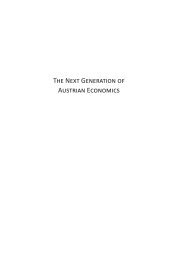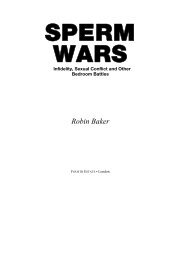capitalist_and_entrepreneur_klein
capitalist_and_entrepreneur_klein
capitalist_and_entrepreneur_klein
Create successful ePaper yourself
Turn your PDF publications into a flip-book with our unique Google optimized e-Paper software.
24 <br />
<strong>capitalist</strong>. I next discuss the Coasian, or “contractual” approach to the<br />
firm <strong>and</strong> argue that it provides a useful organizing framework for Austrian<br />
research on the firm. e subsequent section proposes <strong>entrepreneur</strong>ship<br />
<strong>and</strong> economic calculation as building blocks for an Austrian theory of<br />
the firm. Finally, after a brief review of capital-market behavior <strong>and</strong> the<br />
disciplinary role of takeovers, I outline four areas for Austrian research<br />
in corporate governance: firms as investments, internal capital markets,<br />
comparative corporate governance, <strong>and</strong> financiers as <strong>entrepreneur</strong>s.<br />
Limits of the St<strong>and</strong>ard Approach to the Firm<br />
As we saw in chapter 1, the “firm” of economics textbooks is not really<br />
a firm at all. e firm is treated as a production function or production<br />
possibilities set, a “black box” that transforms inputs into outputs. While<br />
descriptively vacuous, the production-function approach has the appeal<br />
of analytical tractability along with its elegant parallel to neoclassical consumer<br />
theory (profit maximization is like utility maximization, isoquants<br />
are indifference curves, <strong>and</strong> so on). Nonetheless, many economists now<br />
see it as increasingly unsatisfactory, as unable to account for a variety<br />
of real-world business practices: vertical <strong>and</strong> lateral integration, mergers,<br />
geographic <strong>and</strong> product-line diversification, franchising, long-term commercial<br />
contracting, transfer pricing, research joint ventures, <strong>and</strong> many<br />
others. e inadequacy of the traditional theory of the firm explains much<br />
of the recent interest in agency theory, transaction cost economics, the capabilities<br />
approach, <strong>and</strong> other facets of the “new institutional economics.” 1<br />
A more serious problem with the traditional theory, however, has received<br />
less attention. e theory of profit maximization is nearly always told from<br />
the perspective of the manager, the agent who operates the plant, not that<br />
of the owner, who supplies the capital to fund the plant. Yet owners control<br />
how much authority to delegate to operational managers, so <strong>capitalist</strong>s are<br />
the ultimate decision makers. To underst<strong>and</strong> the firm, then, we must focus<br />
on the actions <strong>and</strong> plans of the suppliers of financial capital.<br />
Focusing on capital markets <strong>and</strong> the corporate governance problem<br />
highlights a fundamental analytical problem with the traditional approach<br />
1 e new institutional economics is reviewed <strong>and</strong> critiqued in Furubotn <strong>and</strong> Richter<br />
(1997), Klein (2000), Williamson (2000), Ménard <strong>and</strong> Shirley (2005) <strong>and</strong> Brousseau <strong>and</strong><br />
Glachant (2008).








